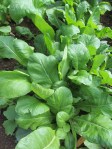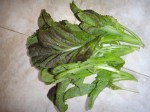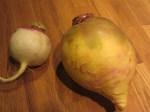Jeanne briefly describes the cultivation history and botany of Brassica rapa, B. napus, B. nigra, and B. juncea to round out our cursory tour of the extraordinary genus Brassica. Michelle offers a recipe highlighting a vegetable likely present at the first Thanksgiving: the turnip, an exceptional cultivar of B. rapa.
Along with the turkey, stuffing, potatoes, green beans and cranberry sauce, Brussels sprouts have become something of a Thanksgiving staple. None of these dishes, however, were part of the original harvest feast shared by the Pilgrims and Wampanoag in Plymouth Colony in 1621. A close relative of Brussels sprouts, however, likely had an honored place at the table: turnips. The Pilgrims chose the tuberous vegetable to occupy precious cargo space in the holds of their ships bound for the New world and grew them in their Plymouth Colony gardens. Turnips were probably also on most Americans’ Thanksgiving menus when President Lincoln made the holiday official in 1863. During that first Thanksgiving turnips served as a sole representative of a genus, Brassica, that has one of the most impressive radiations of cultivated species on the planet. Its extensive domestication happened primarily in Europe and Asia. While Native Americans may have exploited weedy little native species in same family as the now-familiar Brassica (the mustard family, Brassicaceae), there is little evidence that they cultivated them or subjected them to artificial selection.
Descriptions of turnips date to Alexander the Great’s vast kingdom, which spanned much of central Eurasia. The vegetable’s domestication history earlier than that is not well known, but turnips likely made their way to western Europe from an Asian origin, along with several other well-known varietals of the same species, Brassica rapa. In a previous post we discussed the numerous varieties of Brassica oleracea (including kale, collard greens, Chinese broccoli, Brussels sprouts, kohlrabi, cabbage, broccoli, and cauliflower). The radiation of Brassica rapa into several morphologically variable domesticated vegetables across its broad native range in Europe, Asia and North Africa is almost as spectacular as that of B. oleracea. Turnips, Italian rapini, and Asian cultivars bok choy, tatsoi, mizuna greens, napa cabbage, and purple mustard greens are all varieties of B. rapa. In addition to B. oleracea and B. rapa, other important Brassica species in the human diet are Brassica napus (rutabaga and oilseed), Brassica nigra (black mustard) and Brassica juncea (mustard greens). As such, the single genus Brassica alone accounts for a respectable fraction of the vegetables in a well-stocked produce section.
The genus Brassica
Many varietals of B. rapa, B. napus, and B. juncea have been developed for tubers or greens. Turnip cultivars (B. rapa ssp. campestris) are typically grown for their swollen root tuber, but also for their greens. Napa cabbage or Chinese cabbage (B. rapa ssp. pekinensis), a Chinese cultivar, forms a large, impressive, long head of tightly packed leaves with broad, white midribs and curly pale green leaf blades.
Bok choy (B. rapa ssp. chinensis) was developed in China by the fifth century A.D. and looks like a smaller Napa cabbage with more loosely-packed leaves and fleshier white or pale green leaf midribs and thicker, darker green leaf blades.
Tatsoi is similar to Bok Choy but is even smaller yet and darker green. Japanese cultivar mizuna greens (B. rapa ssp. nipposinicai) are whispy, delicate, deeply toothed leaves.
Spicy, green, curly mustard greens are Asian (Chinese, Japanese and Indian) varietals of Brassica juncea. The leaves and stems of green varietals of this herbaceous plant, which are typically cooked or pickled, resemble a lighter, brighter kale but have a more pungent mustard, horseradish-like flavor. Purple mustard greens have a similar pungency but with rich plum and dark green coloring (some of these may be variants of B. rapa).
B. napus varietals include the turnip-like, yellow-fleshed rutabaga root tuber.
Seeds of several Brassica species and other related crucifers are used as spices and oils. Seeds of at least two plant species are the primary ingredients in the condiment mustard. A yellow-seeded variety of the Asian B. juncea, the mustard greens, had been cultivated for centuries in Europe for brown mustard until about the 1950s, when it began to be replaced by another weedy little Mediterranean Brassica annual with a long history of cultivation: black mustard, Brassica nigra, which, unlike B. juncea, can be harvested mechanically. Yellow or white mustard seeds, which are the main ingredient in most commercially available prepared yellow mustard in the United States, are the seeds of Sinapis alba, a close relative of the genus Brassica that has at some points in taxonomic history been subsumed into it. B. nigra seeds are also the dark brown mustard seeds thrown into hot oil and toasted until they pop as the first step in the preparation of many Indian dishes. Part of their explosiveness in the pan is attributable to the high concentration of fat typical of Brassica seeds, which is pressed out and used as a cooking oil throughout much of the world. The oil from these species is, collectively by tonnage, the most abundant cooking oil produced on the planet (Al-Shebaz 2012). The oil is called mustard oil, canola oil, or rapeseed oil, and is actually variously produced from the seeds of three different species of Brassica or their hybrids: B. napus, B. juncea and B. rapa.
B. nigra and B. rapa grow wild as weeds in much of the temperate world, and all of their parts are quite edible, if a bit strongly flavored and tough. If you’re feeling adventurous, you can throw a few wild mustard leaves into our turnip recipe below, which takes cues from China, the center of diversity of the brassicas.
Update (8 April 2013): Some kales, including Red Russian kale, are actually “Siberian kales,” species Brassica napus, the same species as rutabaga, instead of B. oleracea.
Ginger Scallion Noodles with Tokyo turnips and Maitake mushrooms
This recipe highlights the roots and greens of turnips, the glorious and frequently inappropriately maligned cultivar of B. rapa. The recipe calls for Tokyo turnips, or white turnips, small white turnips with thin skin, which are increasingly available in farmer’s markets and some grocery stores. If you can’t find them but can find the larger purple-topped turnips, go ahead and get those, but do taste a raw sliver of it to decide if the skin is thin enough to be left on or needs to be peeled off. If your turnips are missing their greens, use mustard greens if you can find them, or bok choy, kale, or a combination of radish tops, arugula and napa cabbage. Or, go outside and harvest some wild mustard greens! If you can’t find and/or tolerate maitake mushrooms, use your preferred combination of shitake, cremini and oyster mushrooms.
This dish is so satisfying when you are in the mood for a Chinese noodle dish with lots of vegetables and feel the need to cook and not order in. It is inspired by the Momofuku recipe, which was in turn inspired by the classic Chinese take out dish. The small Tokyo turnips are perfect because they don’t need peeling and their greens take on a quick pickle flavor with the addition of vinegar. Don’t let all the long list of directions dissuade you. You are simply making some sauce, very quickly cooking some vegetables and boiling some noodles. If you have access to fresh noodles, use those!
1/2 pound of dried lomein noodles
2 pounds of Tokyo turnips with their greens
1/2 pound of maitake mushrooms, sliced
1 bunch of scallions
1/4 cup of peeled, minced ginger
3-4 teaspoons sherry vinegar
1 teaspoon soy sauce
1/4 cup peanut or grapeseed oil
Salt
Wash scallions, trim each end and peel off the outer layer of onion skin. Thinly slice the scallions, both the white and green parts, and put in a small bowl with the minced ginger, 1 teaspoon of sherry vinegar, soy sauce and 2 tablespoons of oil. Stir all ingredients together and set aside the ginger and scallion sauce.
Rinse the turnips and their greens. Cut off the greens and slice in 1/4 inch bands. Trim each turnip of its tail, cut in half and slice 1/4 inch thick.
In a medium pot, bring water to a boil for the noodles. Cook noodles for 5-6 minutes until tender but toothsome.
Meanwhile, heat a large sauté pan over high heat. Pour in 2 tablespoons of oil, swirl the pan and add the mushrooms. Give the mushrooms a quick stir to coat with oil and sauté until a golden brown crisp, about 3-4 minutes. Season with salt and remove mushrooms from the pan. Add turnips to the same pan and continue cooking on high heat for a minute. Remove turnips from the pan and set aside with the mushrooms. Finally, add the turnip greens to the pan and cook until the greens wilted, about 1 minute. Season with salt and a teaspoon or two of sherry vinegar.
Drain noodles and toss with ginger scallion sauce. Divide noodles between 4 bowls and top each bowl with a little pile of mushrooms, turnips and greens.
Serve with hoisin and chili sauce on the side.
References
Al-Shehbaz, I. A. 2012. Systematics and phylogeny of the mustard family. Missouri Botanical Garden.
Vaughan, J. G., and A. Geissler. 2009. The New Oxford Book of Food Plants. Oxford University Press, New York.













Pingback: The most political vegetables: A whirlwind tour of the edible crucifers | The Botanist in the Kitchen
Pingback: Greens: why we eat the leaves that we do | The Botanist in the Kitchen
Pingback: The extraordinary diversity of Brassica oleracea | The Botanist in the Kitchen
Pingback: Maca: A Valentine’s Day Call for Comparative Biology | The Botanist in the Kitchen
Pingback: Botany Lab of the Month: Jack-O-Lantern | The Botanist in the Kitchen
Pingback: Botany lab/rant of the month: that’s a magic beanstalk, not a soybean | The Botanist in the Kitchen
Pingback: Botany lab of the month: Contrasting brassica plants in the garden | The Botanist in the Kitchen